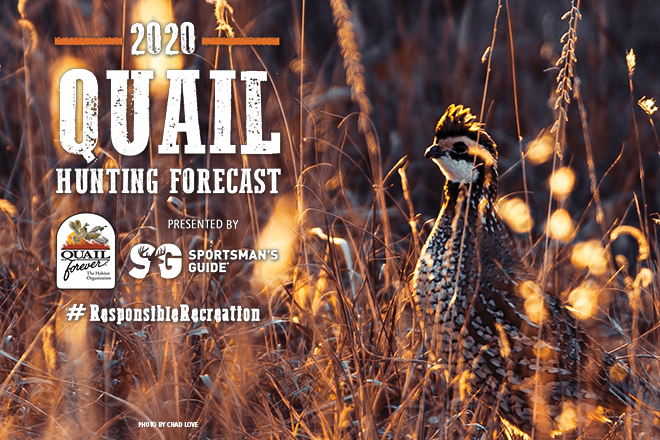
By Ted Gartner
Editor's Note: If you’re reading this forecast, that means you have a passion for quail. Turn that passion into support by joining, renewing, or upgrading your membership Quail Forever. We are in the business of making habitat for the birds you love. Since its inception in 2005, QF has impacted over 1 million acres of habitat through its chapter volunteers, staff and partnerships. We ARE making a difference, and with your help, we can ensure our children will know the thrill of a staunch dog and a rising covey. Give back to the birds that give us all so much and show your support. Join, renew or extend your membership, and for a limited time get an awesome QF hoodie as our special gift to you!
This could be a banner season for Gambel’s quail in Arizona this year, with late or multiple hatches, gigantic coveys, and survey numbers not seen in 30 years.
Weather and Conditions
“We had a second wet winter here in Arizona, so that supported lots of reproduction in desert quail. This is going to be a Gambel's quail hunting year!” says Larisa Harding, small game program manager for the Arizona Game and Fish Department. Quail sightings and surveys would seem to back up Harding’s optimism.
All of the breeding call count surveys this spring were up — way up. All of the long-term quail survey routes in southern Arizona reported at being 1.5 to 2 times the recent 10-year average, which are numbers that have not been seen since the 1990s. The newer routes in the central and northwestern portions of the state reported their highest numbers yet, with most being twice as high as what has been recorded in the past five years.
“Taking everything into account, this will be a great season compared to what we have experienced in the last 15 or more years. Quail are starting to pop up in places they haven’t been seen in a while,” Harding explains. “If you’ve never had the chance to experience what Arizona quail hunting built its name on, then this would be the year to get out and enjoy chasing Gambel's quail.”
Good winter precipitation also fell in scaled quail country, and there were several good reports on hatches this spring, but the weak monsoon patterns appeared to reduce the number and size of scaled quail coveys such that their numbers are average at best. The summer call counts suggest that scaled quail may be more scarce and difficult to find in desert country this year.
Habitat, Broods and Counts
Harding says this probably isn’t the best year to hunt Mearns', or Montezuma, quail. Mearns' quail depend on monsoonal moisture, and timing and location of rainfall also influence their nesting success and population numbers.
“This is the second summer of widespread 'nonsoons' instead of monsoon moisture. While the birds are likely to be more abundant in pockets that received precipitation this summer, their numbers may be generally more depressed,” says Harding.
Not only have the monsoons not done their job, but Arizona has had one of its hottest summers on record. Winter/spring-grazed areas aren't likely to be producing much new forage or cover for quail, and tanks and other water supplies have dried up almost everywhere. And the drought has allowed an invasive plant to take hold.
“In the desert areas, particularly closer to metro centers like north Phoenix, you'll see the explosion of stinknet, or Globe Chamomile, which is an invasive annual,” says Harding. “It has covered large areas and all but choked out the native annuals and forbs. We don't quite know how the quail are going to respond to that over the next few years.”
Perhaps the most interesting observation would be that Gambel's chicks were still hatching into the early weeks of July, thanks to winter and early spring rains that lengthened out the breeding and nesting period and spread the hatch out.
Gambel’s coveys had lots of chicks, with Harding counting 12-15 chicks per adult pair on more than one occasion. Several coveys that Harding has observed have numbered 40 to 70 birds.
Top Spots
For desert birds, Harding recommends southeastern Arizona or out towards the area west of Hwy 93 between Wickenburg and Kingman, or near the Lake Pleasant area.
For Mearns', the traditional stronghold is in southeastern AZ, but because the population is down, seek out-of-the-way areas that don’t get much pressure.
Insider Tip
Arizona and much of the desert southwest is difficult terrain for a bird dog. Make sure you’ve got boots on hand for encounters with cactus, thorns, sharp rocks. Keep a first aid kit on hand and always carry plenty of water.